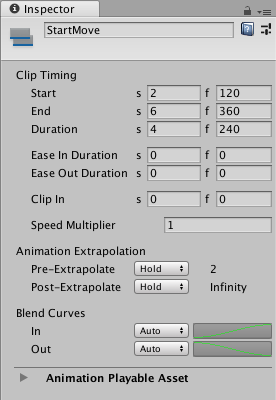Animation clip common properties
Use the InspectorA Unity window that displays information about the currently selected GameObject, Asset or Project Settings, allowing you to inspect and edit the values. More info
See in Glossary window to change the common properties of an Animation clipAnimation data that can be used for animated characters or simple animations. It is a simple “unit” piece of motion, such as (one specific instance of) “Idle”, “Walk” or “Run”. More info
See in Glossary. The common properties of an Animation clip include its name, timing, play speed, blend properties, and extrapolation settings.

Display Name
The name of the Animation clip shown in the TimelineGeneric term within Unity that refers to all features, windows, editors, and components related to creating, modifying, or reusing cut-scenes, cinematics, and game-play sequences. More info
See in Glossary window.
Clip Timing properties
Use the Clip Timing properties to position, change the duration, change the ease-in and ease-out duration, choose the extrapolation mode, and adjust the play speed of the Animation clip.
Most timing properties are expressed in both seconds (s) and frames (f). When specifying seconds, a Clip Timing property accepts decimal values. When specifying frames, a property only accepts integer values. For example, if you attempt to enter 12.5 in a frames (f) field, the Inspector window sets the value to 12 frames.
Depending on the selected Clip Edit mode, changing the Start, End, or Duration may blend, ripple, or replace Animation clips on the same track.
| Property | Description |
|---|---|
| Start | The frame or time (in seconds) when the clip starts. Changing the Start changes the position of the clip on its track in the Timeline Asset. Changing the Start also affects the End. Changing the Start sets the End to the new Start value plus the Duration. |
| End | The frame or time (in seconds) when the clip ends. Changing the End also affects the Start. Changing the End sets the Start to the new End value minus the Duration. |
| Duration | The duration of the clip in frames or seconds. Changing the Duration also affects the End. Changing the Duration sets the End to the Start value plus the new Duration. |
| Ease In Duration | Sets the number of seconds or frames that it takes for the clip to ease in. If the beginning of the clip overlaps and blends with another clip, the Ease In Duration cannot be edited and instead shows the duration of the blend between clips. See Blending clips. |
| Ease Out Duration | Sets the number of seconds or frames that it takes for the clip to ease out. If the end of the clip overlaps and blends with another clip, the Ease Out Duration cannot be edited and instead shows the duration of the blend between clips. In this case, trim or position the clip to change the duration of the blend between clips. See Blending clips. |
| Clip In | Sets the offset of when the source clip should start playing. For example, to play the last 10 seconds of a 30 second Animation clip, set Clip In to 20 seconds. |
| Speed Multiplier | A multiplier on the playback speed of the clip. This value must be greater than 0. Changing this value changes the duration of the clip. |
Animation Extrapolation
Use the Animation Extrapolation properties to set the gap extrapolationHow an Animation track approximates animation data in the gaps before and after an Animation clip. More info
See in Glossary before and after an Animation clip. The term gap extrapolation refers to how an Animation track approximates or extends animation data in the gaps before, between, and after the Animation clips on a track.
There are two properties for setting the gap extrapolation between Animation clips. The Pre-Extrapolate property only appears for Animation clips.
| Property | Description |
|---|---|
| Pre-Extrapolate | Controls how animation data is approximated in the gap before an Animation clip. The Pre-Extrapolate property affects the easing-in of an Animation clip. |
| Post-Extrapolate | Controls how animation data extends in the gap after an Animation clip. The Post-Extrapolate property affects the easing-out of an Animation clip. |
Blend Curves
Use the Blend Curves to customize the transition between the outgoing and incoming Animation clips. See Blending clips for details on how to blend clips and customize blend curves.
When easing-in or easing-out clips, use the Blend Curves to customize the curve that eases-in or eases-out an Animation clip. See Easing-in and Easing-out clips for details.
- 2019–08–20 Page published